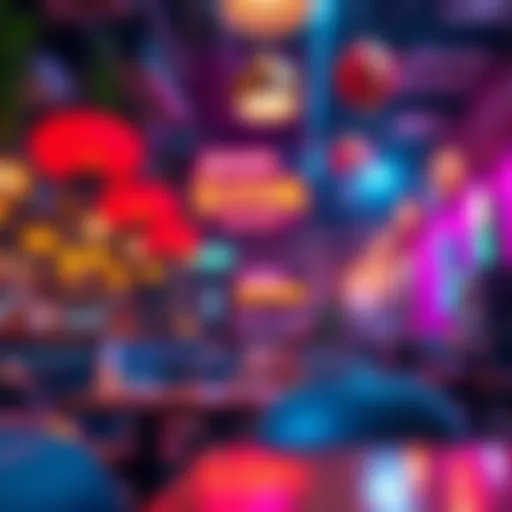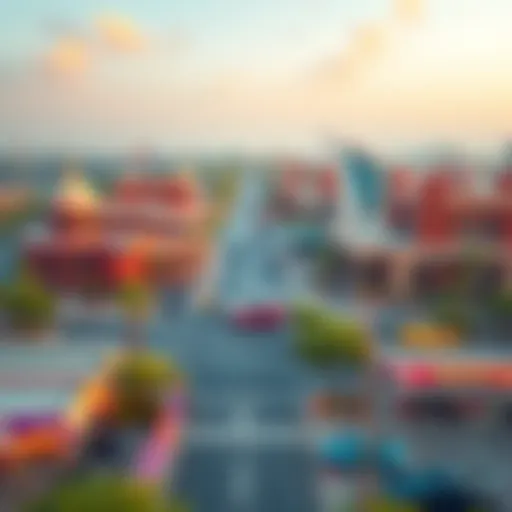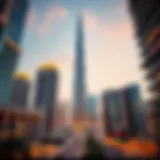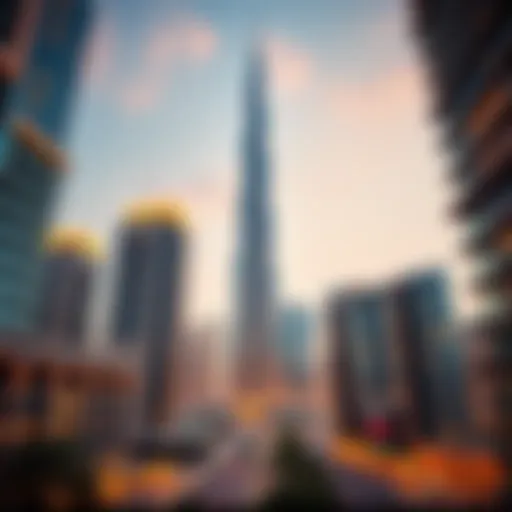The Design House Dubai: A Journey Through Architectural Identity


Intro
Dubai stands at the crossroads of tradition and modernity, a city that has transformed into a global icon for creativity and innovation. The design houses scattered throughout this urban landscape not only represent architectural marvels but also serve as a testament to the evolving identity of Dubai. This exploration into the architectural character of design houses in Dubai highlights their significance in shaping the city’s skyline and influencing the lifestyle of its inhabitants.
The interplay between contemporary and traditional design elements creates a unique aesthetic, often mirroring the cultural tapestry that defines the region. In an era where globalization significantly impacts architectural trends, Dubai's design houses manage to carve a niche that balances both local heritage and international influences. As we navigate through this intricate world of design, various aspects come into play— from the neighborhoods housing these architectural gems to the lifestyle they promote.
This article aims to guide expatriates, tourists, locals, and real estate agents through the enchanting realm of Dubai’s architectural identity. We will delve into neighborhood characteristics and how they contribute to the ambiance of the design houses. Furthermore, we'll analyze the cost of living, exploring whether the high price tags truly reflect the value one gets. Additionally, the lifestyle insights, including cultural and recreational activities along with local dining experiences, will reveal what it means to live, visit, or work in proximity to these remarkable structures.
Stay tuned as we uncover the elements that make Dubai a magnificent hub for architects, designers, and creatives alike.
Foreword to the Design Landscape in Dubai
Dubai's design landscape is a vast tapestry woven with threads of tradition, innovation, and ambition. This article sheds light on how the Design Houses in Dubai serve as pivotal architects of this evolving narrative. The importance of this landscape cannot be overstated; it acts as a mirror reflecting the socio-economic shifts, cultural richness, and forward-thinking ethos that characterizes this vibrant metropolis.
From the sprawling desert to the glittering skyline, architecture in Dubai holds a profound significance, shaping not only the city's physical space but also its identity. Architects and designers here are not just constructors of buildings; they are storytellers crafting the foundations upon which life unfolds. Consider how the Burj Khalifa or the Dubai Opera have become more than mere structures; they are landmarks that communicate the history and aspirations of the Emirate.
Exploring the design landscape involves numerous elements.
- Architectural Diversity: In Dubai, various architectural styles coexist, ranging from contemporary to traditional. Each structure is a testament to the city’s past and an insight into its future.
- Sustainability: Recent trends emphasize eco-friendly practices, indicating a shift towards a more responsible approach to urban development. Design houses are at the forefront, integrating green technology into their projects.
- Cultural Value: Structures often draw from the rich cultural heritage of the Emirate, infusing buildings with local narratives and artistry, thus inviting users to experience Dubai’s rich tapestry.
For expatriates, tourists, locals, and real estate agents alike, understanding this landscape is crucial. It informs decision-making—whether it be in tourism strategies or real estate investments—by illuminating the underlying currents that drive the market. Moreover, design houses are essential advocates for urban development, directly influencing city planning and pioneering lifestyle-enhancing practices.
"The role of design in Dubai is not merely about aesthetics; it encapsulates visions of future living while honoring the cultural past."
In the following sections, we will explore how these design houses emerge as harbingers of architectural identity, translating complex ideas into physical forms that resonate with the populace. This exploration will enrich your understanding of Dubai as a place where creative visions translate into tangible reality.
Historical Context of Architecture in Dubai
Understanding the historical context of architecture in Dubai is vital for anyone keen to grasp the essence of the city’s architectural identity. This backdrop serves as a lens through which we can observe not only the evolution of structures but also the broader narrative of cultural and economic transformation. It effectively demonstrates how unique styles emerged from the interplay of tradition and innovation, offering a compelling story of a city that has evolved dramatically over a short period.
The architectural journey of Dubai can be seen as a reflection of its socio-economic landscape. The transformation from a modest fishing village to a bustling metropolis didn’t simply affect the skyline; it altered the identity of its inhabitants, their lifestyles, and their interaction with the world. From the way buildings responded to climate to how communal spaces were defined, architecture remained at the heart of these changes.
Pre-Oil Era Architecture
Before Dubai struck oil, its architecture was primarily influenced by the harsh desert environment and local traditions. Early structures, including the iconic wind towers (known as "barjeel"), were not merely aesthetic but functioned as ingenious solutions to the sweltering climate. These towers captured cool breezes, allowing heat to escape and providing relief in homes long before modern air conditioning was a notion.
Local materials such as coral stone, mud, and palm fronds were extensively utilized. The concept of communal living was also embodied in these structures; homes often blended seamlessly with the surrounding environment, reflecting the communal values of Emirati society.
- The use of intricate geometric patterns and calligraphy reflected the region's rich cultural stories.
- Structures like the Al Fahidi Fort serve as tangible reminders of the city’s past, showcasing both defensive architecture and beautiful craftsmanship.
Dubai’s pre-oil architecture was less about grandeur and more about functionality and adaptation. It tells tales of survival and community, with homes designed not just for families, but to accommodate the social fabric of that era.
Post-Oil Boom Developments
The discovery of oil in the 1960s radically transformed Dubai’s architectural landscape. With an influx of wealth, the city saw an ambitious wave of construction that introduced modernist and futuristic styles. High-rise buildings began to dominate the skyline, pushing the boundaries of engineering and design.
Architects employed a blend of global influences and local materials, leading to the creation of some of the most iconic structures of today. The Burj Khalifa, for instance, epitomizes both modern engineering and traditional elements, capturing the spirit of Dubai’s aspirations.
In this new architectural boom, sustainability began to factor into design philosophy, showing a shift toward integrating environmentally friendly practices in response to rapid urbanization. Moreover, the desire for cultural identity also became paramount in architectural designs:
- Designers started weaving traditional motifs into contemporary formats, creating a narrativ that highlights both local heritage and global innovation.
- Projects like the Dubai Opera brought forward the idea that buildings can be cultural statements, mingling art with architecture.
Reflecting on these transformative years, it’s evident that the post-oil boom has not just created a skyline, but also a complex identity that merges historical significance with contemporary ambitions.
Architecture in Dubai is a story of adaptation, innovation, and cultural integration—a testament to the city’s relentless pursuit of excellence while respecting its roots.
Defining the Concept of a Design House
Understanding the essence of a design house is crucial in dissecting Dubai's architectural identity. A design house is not merely a structure; it envisions a nexus of creativity, culture, and urban planning. These entities play an intricate role in molding the fabric of the urban landscape, steering the conversation towards innovation and sustainability.
A design house serves as a platform where architecture and artistic vision intertwine. They focus on more than aesthetics; they emphasize functionality, integrating the environment with human needs. Thus, they address pressing concerns like space optimization and community engagement, steering clear of cookie-cutter designs.
Moreover, the implication of a design house extends far and wide. By collaborating with local artisans and embracing sustainable practices, they foster economic growth, create jobs, and push for a more inclusive society. In many ways, a design house acts as a cultural ambassador, translating the ethos of Dubai into tangible forms. This significantly influences not just the skyline but also the lifestyle of its inhabitants.
“A design house embodies the spirit of its community, marrying tradition with innovation to create spaces that are functional yet rich in cultural narrative.”


Role and Influence in Urban Development
The role of design houses in urban development cannot be overstated. They influence city planning through innovative approaches to space and form and consistently challenge conventions to enhance livability. Their architects and designers curate environments that welcome diversity, facilitating social interaction and a sense of belonging among residents.
Design houses stand as symbols of urban evolution, acting as catalysts that inspire change. They are often at the forefront of regeneration projects, breathing new life into tired or underused areas. For instance, imagine the transformation of an abandoned warehouse into a vibrant community center—this is the power of a well-conceived design house.
In Dubai, where space is paramount, the efficient use of every square meter has become a design house's forte. They balance the demands of functionality with the aesthetic flush inherent to the city’s character, shaping the community while preserving its essence.
Design Philosophy and Aesthetic Values
The philosophical underpinning of a design house is crucial to understanding its aesthetic values. Each design house in Dubai articulates its vision, reflected in structures that resonate with the cultural tapestry of the region while embracing modern influences. This blend is not merely visual; it encapsulates the values and aspirations of Emirati society.
Designers often prioritize continuity and context when creating spaces. They respect traditional motifs and craftsmanship while incorporating modern materials and techniques. This duality creates a conversation between the past and present, fostering a deeper connection with inhabitants. For example, one might observe how modern glass facades echo traditional mashrabiya screens, allowing for ventilation while preserving privacy.
Furthermore, a design house’s aesthetic values resonate with sustainability. Architects look to the future, opting for methods and materials that reduce waste and consider long-term environmental impact. By designing with an ecological ethos, these houses do not just respond to the immediate needs of their users but think ahead, ensuring resilience for future generations.
Through this lens, the design house emerges as a formidable entity, contributing not only to the skyline of Dubai but to the broader narrative of its identity, culture, and community.
Notable Design Houses in Dubai
Design houses in Dubai are more than just structures; they symbolize the city's evolving architectural narrative. They highlight a mix of tradition and modernity, reflecting the culture, ambition, and artistry of the emirate. Not only do these houses enhance the city's skyline, but they also serve as creative hubs where innovation flourishes. In this section, we’ll explore some of the standout names that have left an indelible mark on Dubai’s design landscape, examining their contributions and distinctive characteristics.
House of Design
The House of Design stands tall as a testament to the unique architectural vision that characterizes Dubai. This establishment offers a collection of avant-garde blueprints that push the boundaries of conventional design. It’s not just about aesthetics; it’s about creating spaces that ooze functionality while still behaving artistically. From sleek residential buildings to innovative commercial spaces, the House of Design actively engages clients in the creative process. By involving future occupants in the planning stages, they ensure that the final product is not only visually striking but also deeply functional.
Key Features of the House of Design:
- Collaborative Approach: They work alongside their clients, incorporating feedback to merge artistic vision and practical needs.
- Sustainable Practices: Emphasizing eco-friendly techniques, they are keen on minimizing the environmental footprint of each project.
- Culturally Relevant Design: They often infuse local cultural elements into their projects, providing a sense of identity even amid modernity.
Innovative Spaces
As the name suggests, Innovative Spaces stretches the imagination of what design can achieve. This design house is known for crafting environments that blend technology and creativity seamlessly. With an eye on future needs, they explore new materials and construction techniques, providing unconventional yet practical solutions that redefine spatial dynamics. Their projects are often seen as experimental labs, where architecture turns into an ever-evolving discipline.
Highlights of Innovative Spaces:
- Transitional Designs: Projects that change purpose over time, allowing spaces to adapt to future needs.
- Integration of Technology: Use of smart technology to enhance usability and user experience.
- Community-Centered Projects: Spaces designed not just for individuals, but for building community connections and experiences.
Local Artisans and Craftsmanship
Losin sight of the significance of local craftsmanship in modern architecture would be an oversight. Various design houses in Dubai have developed partnerships with local artisans, ensuring that traditional techniques and materials are not lost. These artisans bring a wealth of knowledge and skills, enriching the design process with their cultural heritage and local wisdom.
“The blend of traditional artisanship with modern design creates a narrative that speaks of both history and progression.”
Contributions by Local Artisans:
- Intricate Detailing: Handcrafted elements that tell a story and add depth to design.
- Use of Indigenous Materials: Ensuring a connection to the land through sustainable and locally sourced materials.
- Cultural Preservation: Keeping alive the legacy of Emirati heritage while integrating it into contemporary designs.
Each of these design houses adds to the rich tapestry of Dubai's architectural identity, showcasing how different influences can intertwine and create something truly remarkable. As the city continues to evolve, it will be fascinating to see how these establishments adapt and inspire future generations of architects and designers.
Architectural Styles and Trends
Architectural styles and trends serve as the visible narrative of a city, reflecting not just aesthetic choices but also cultural evolution and societal values. In Dubai, where rapid growth and dynamic cultural exchanges shape each corner of the urban landscape, these styles act as the pulse of the city, marking significant transitions in its architectural identity. Exploring these trends might unveil layers of meaning embedded in the structures that dot the skyline.
Contemporary Emirati Architecture
Contemporary Emirati architecture represents a shift from traditional designs to more innovative and expressive modern forms. Gone are the days when beige stucco and throwbacks to the desert palette defined the city’s buildings. Today, architects have ventured into a framework of sleek lines, glass façades, and bold geometric shapes that challenge conventions and invite interaction. This style embraces the spirit of the Emirati culture with its focus on openness and social connectivity.
Aspects of contemporary Emirati architecture vary from simple forms and monumental designs to intricate patterns that echo Islamic art. The emphasis on local materials continues to ground modern structures in regional identity while still allowing for a broad palette of design possibilities. Notably, landmarks like the Burj Khalifa and Dubai Opera showcase how the contemporary narrative seamlessly aligns with tradition and innovation.
Integration of Sustainable Practices
In light of the pressing global need for sustainability, the future of architecture in Dubai increasingly includes eco-friendly principles aligned with the UAE's vision to develop a green economy. Integrating sustainable practices doesn’t merely serve a moral obligation; it also fosters long-term viability for the city’s expansion while minimizing negative impacts on the environment.
Architects are incorporating solutions that embrace renewable energy sources, such as solar panels, and optimizing natural light to reduce energy consumption. Sustainable water management systems are also becoming common in residential and commercial projects, demonstrating an understanding of the desert climate’s particular demands.


However, embracing sustainability also means grappling with the nuances of Emirati culture. Striking a balance between innovation and tradition remains a challenge, yet many design houses are rising to the occasion, exhibiting a commitment to environmental stewardship without erasing cultural significance.
Use of Advanced Technologies
The integration of advanced technologies into Dubai's architectural panorama shapes a unique narrative of innovation. From building information modeling (BIM) to augmented reality and 3D printing, modern tools are reimagining how design houses conceive and execute their projects.
This tech-savvy approach serves not only to elevate efficiency but also increases the accuracy of project delivery and enhances the sustainability of materials used. One striking example includes the Dubai Smart City initiative, which leverages tech to bolster urban living experiences while accommodating a growing population.
The adoption of technology goes beyond mere construction methods; it extends into everyday life through smart buildings that feature user-interactive designs. These not only cater to practical functions but also enhance the overall experience of living and working in Dubai, reflecting a progressive mindset in architecture.
Architectural identity is not static—it evolves, reflects community values, and adapts to the landscape.
In synthesis, the exploration of architectural styles and trends in Dubai reveals both the historical context and the forward-looking vision of its architectural identity. By investing in sustainable design, staying attuned to contemporary needs, and employing advanced technologies, Dubai's design houses are not just building structures; they are fashioning the narrative of a city that is both rooted in tradition and soaring towards the future.
The Cultural Significance of Design in Dubai
The architectural landscape of Dubai does more than meet the eye; it serves as a canvas that depicts the region's rich cultural tapestry. The significance of design within Dubai isn't merely about aesthetics or the impressive skyline. It unfolds a narrative that intertwines the past with the present, tradition with modernity, and local with global perspectives. The city’s design houses actively contribute to this dialogue, providing not only structures but a sense of identity and belonging.
Design in Dubai reflects the unique cultural amalgamation resulting from rapid urbanization and globalization. This context forms fertile ground for debate on identity, pride, and the essence of contemporary Emirati life. The diverse projects led by distinguished design houses illuminate the depth of influence from ancient practices, local stories, and innovative techniques, resulting in spaces that resonate with both locals and expatriates.
Furthermore, the city's architecture acts as a vital medium of communication. Each building has its own tale. For instance, the use of bright colors and intricate patterns often seen in structures signifies a cultural value that echoes traditional artistry from the region. This is essential for fostering community connections, serving as a cultural emblem that people can rally around and relate to, amid the bustling surroundings.
As the city continues to evolve, the interplay between cultural fixtures and modern interpretations becomes increasingly significant. The historical roots embedded in each design have a way of creating a familiar sense of place, giving both residents and visitors a collective experience that fosters shared understanding.
"In architecture, a story is not just told through the design itself but also through the experiences shared within its walls."
Symbolism in Architectural Designs
In the rich tapestry of architecture in Dubai, symbolism plays an essential role. Each design element can be seen as a signal of cultural heritage while also embracing innovation. For example, the prominent presence of geometric patterns in many structures echoes Islamic traditions, marrying spirituality with modernity. This can be observed in landmarks like the Burj Khalifa, which not only ascends into the sky but also intricately connects to the ground below through historical symbolism.
Architects often utilize local motifs to recall the region's heritage while integrating functionality. The mashrabiya—a traditional design feature—acts as both a climatic solution and an artistic expression. It allows inhabitants to enjoy natural airflow and shade while also serving as a visual barrier, thus echoing the traditional social structures of privacy and hospitality deeply rooted in Emirati culture.
Additionally, buildings like the Dubai Opera reveal strikes of symbolism that convey the narrative of a city pushing toward the future while being anchored in its past. The fluid design of the structure mirrors the waves of the Arabian Gulf, signifying a relationship with the natural environment and the historical reliance on maritime commerce. Symbolism here becomes a bridge connecting architectural practice with the collective memory and identity of the community.
Bridging Tradition with Modernity
In a city where sand dunes meet skyscrapers, Dubai stands as a testament to the successful blend of traditional values with modern design sensibilities. The architectural identity reflects this balance—design houses continuously push the envelope, capturing the essence of what it means to be Emirati today while also preserving ancient traditions.
For instance, many modern buildings incorporate mashrabiya panels and incorporate features like courtyards—elements that harken back to traditional designs while benefiting from modern materials and construction techniques. This combination not only respects the past but enhances the urban experience, offering inhabitants a taste of old-world charm amidst cutting-edge innovation.
The concept of "Iwan," a traditional architectural layout where an open space is framed by a roofed structure, is finding its way into modern designs in Dubai. By reimagining these classical forms into new contexts, architect firms can create spaces that feel familiar yet fresh, allowing residents to relate to their environment deeply.
Further, initiatives focused on restoring historical areas have risen, showcasing a commitment to preserving culture within the urban fabric. The Al Fahidi Historical Neighborhood stands as a pinnacle of this approach. While it preserves the traditional sand-colored buildings that narrate a story of time and place, it also incorporates modern amenities necessary for urban living—striking a delicate balance between preservation of culture and adapting to contemporary needs.
This blend plays an essential role in creating a cohesive identity for the residents and newcomers alike, addressing the distinct flavors of Dubai's unique environment, while fostering an atmosphere ripe for collaboration and creativity.
Challenges Faced by Design Houses
In the urban sprawl and architectural richness of Dubai, design houses play a pivotal role in shaping the city's identity. However, these entities operate within a landscape fraught with challenges that can impede their creativity and sustainability. Understanding these obstacles is not merely academic; it shines a light on the resilience and innovation inherent in Dubai's design community. Addressing issues such as urbanization, economic variability, and evolving consumer preferences is paramount for ensuring that design houses can continue to thrive.
Urbanization and Space Constraints
With the rapid expansion of Dubai, urbanization presents a double-edged sword. On one hand, it fuels the demand for innovative design; on the other, it imposes severe constraints on available space.
Design houses often find themselves squeezed into smaller plots, where creativity must flourish amid notable constraints. It's not uncommon to witness breathtaking buildings perched atop compact bases, their designs pushed to the limits of residential or commercial viability. For instance, a renowned local design house recently implemented vertical gardens in their structures, finding a way to introduce greenery without expanding their footprint.
These adaptations highlight both an opportunity and a pressure to innovate. Limited space necessitates agile thinking. Designers must think outside of the box—sometimes literally—to maximize usage while maintaining aesthetic appeal. Moreover, the growing trend toward mixed-use developments combines living, working, and leisure spaces, pushing design houses to collaborate across various fields. The challenge lies not just in spatial restrictions but also in navigating regulations and zoning laws that often do not keep pace with the lightning speed of urban development.
Economic Fluctuations and Demand
The volatility of Dubai's economy also poses a significant challenge for design houses. Fluctuations in oil prices and global economic conditions directly impact real estate and infrastructural investments. During lean periods, design houses often see a dip in projects, leading to potential layoffs or, in extreme cases, shuttering their doors.
Moreover, economic shifts influence consumer confidence. A luxury home might be the foremost desire during a boom, but during downturns, more affordable, practical designs gain traction. Consequently, design houses must remain nimble and responsive. Some have diversified their portfolios to include lower-cost, functional builds alongside their high-end offerings. This strategy not only cushions against market volatility but also opens new revenue streams.
As design houses navigate these economic waters, they must employ strategic foresight. Keeping abreast with global market trends is essential, as is fostering relationships with stakeholders. For example, actively engaging with local communities and governmental bodies can lead to lucrative partnerships, creating designs that respond to the needs of the populace while being profitable in return.


"In a world where change is the only constant, adaptability is key to survival and success."
The Future of Design in Dubai
As we cast an eye towards the horizon of architectural innovation in Dubai, it becomes evident that the future of design here is not merely a progression of style but a profound reflection of cultural identity and environmental responsibility. The design houses in Dubai are not just buildings; they are representations of the metropolis' evolving narrative.
Emerging Design Trends
One cannot ignore the wave of emerging design trends that are beginning to refashion the urban landscape of this vibrant city. These trends are characterized by a cross-fertilization of traditional Emirati elements with cutting-edge technology. Here are a few notable directions:
- Biophilic Design: The integration of nature into architecture is becoming pivotal. Designers are weaving green spaces into urban environments, not only for aesthetics but also for enhancing the wellbeing of inhabitants.
- Sustainable Practices: The focus on sustainability is gaining momentum, as evidenced by the adoption of renewable energy sources, such as solar panels and sustainable materials. For instance, certain projects are utilizing recycled materials, minimizing waste during construction.
- Smart Buildings: Incorporating smart technology into buildings is trending. This includes automated systems for energy use, temperature control, and safety measures. The Collective, for example, is one of the few buildings featuring such technology, allowing it to adapt to changing conditions.
- Cultural Fusion: Embracing designs that reflect the multicultural fabric of Dubai while respecting traditional motifs is another trend. The blend of various styles, from minimalist Scandinavian to opulent Arabian, creates a unique architectural dialogue.
These trends are not just isolated phenomena; they reflect a broader shift towards an inclusive, responsive design culture that values the interconnectedness of space and society. In a bustling city where the skyline is a canvas, each new structure tells a story that blends innovation with heritage.
The Role of Community Involvement
The community plays an integral role in shaping the future of design in Dubai. As more design houses encourage participation from locals, the architectural contexts become richer and more grounded. Community involvement fosters a sense of ownership and belonging, as residents can voice their needs and aspirations.
"Design is not just what it looks like and feels like. Design is how it works." — Steve Jobs
Engaging the community can take several forms:
- Workshops and Seminars: These allow local stakeholders to share their ideas and contribute to project planning. Understanding the wishes of the community helps designers create spaces that resonate with the culture and lifestyle of Dubai.
- Public Art Projects: Incorporating art allows communities to express themselves. Projects like the Al Fahidi Historical Neighborhood have shown how public art can attract both locals and tourists, enhancing the overall experience of spaces.
- Sustainable Initiatives: Community-driven sustainability efforts can lead to greener neighborhoods. Initiatives such as community gardens or local clean-up days promote environmental responsibility and enhance public spaces.
For further exploration on design trends and sustainability in architecture, you might find these resources helpful:
- Wikipedia - Architecture in Dubai
- Britannica - Urban Design
- Community Involvement in Design
- Sustainable Architecture
Through narrative and engagement, the future of design in Dubai will surely continue to unfold in fascinating ways.
The End: The Architectural Identity of Dubai
The architectural identity of Dubai stands as a vibrant testament to the city’s transformation over recent decades. It is more than just a collection of buildings; it reflects a profound narrative woven through culture, history, and modern aspirations.
The design houses nestled within this bustling metropolis play a pivotal role. They don't merely create structures; they mold the character of urban life. For expatriates, tourists, and locals alike, these hubs of creativity symbolize a harmonious blend of tradition and innovation. Each design house contributes distinctively, showcasing how the past can inform the future while pressing toward new horizons.
As outlined in this article, several key elements define this architectural identity:
- Cultural Syncretism: The influences of Middle Eastern heritage coupled with contemporary styles highlight a unique aesthetic. Buildings are not built in isolation but rather emerge from the interplay of global design trends and local traditions.
- Sustainability and Innovation: The increasing focus on eco-friendly materials and energy-efficient designs reflects a growing awareness and responsibility toward the environment. Design houses are leading the charge in utilizing cutting-edge technologies, thereby addressing global concerns through localized efforts.
- Community Engagement: There’s a notable shift towards involving the local populace in design processes. This shifts away from the typical top-down approach to a more inclusive model, enriching the architectural narrative.
Nevertheless, the city's architectural identity faces challenges as urbanization presses on. A constant balancing act must exist between maintaining Dubai's rich cultural roots and accommodating rapid growth and change. This makes the role of design houses even more essential, as they must navigate these complexities to ensure that the essence of Dubai is preserved.
In summary, the architectural identity of Dubai is a dynamic interplay of the past and the budding future. It's a living, breathing entity that thrives on collaboration, reflection, and a willingness to adapt. As the city evolves, so too will its architecture, bearing witness to its identity, aspirations, and the dreams of those who inhabit it.
"Architecture is not just about building; it’s about building meaning that resonates with places and people."
To delve deeper into the intricacies of Dubai's architectural narrative, consider exploring resources like Wikipedia and Britannica which offer expansive insights into the cultural and historical context driving these spectacular designs.
References and Further Reading
Understanding the architectural landscape and its development in Dubai requires a solid foundation of knowledge. This section is critical as it offers a well-curated reference point for those seeking to broaden their understanding of the design houses, architectural trends, and cultural impact mentioned throughout this article.
Importance of References
The exploration of unique architectural identity cannot be taken lightly. A well-researched backing allows readers to appreciate not just the aesthetics but also the historical and cultural narratives embedded in Dubai’s architecture. Here’s why references matter:
- Historical Context: Many architectural elements in Dubai are influenced by historical contexts, especially the pre-oil era and post-oil boom periods. Resources like en.wikipedia.org provide essential information on how these eras shaped the current skyline.
- Architectural Techniques: References to academic articles can illuminate advanced technologies and construction methods employed in local design houses. Sites like britannica.com are helpful for understanding these concepts.
- Cultural Significance: Understanding the symbolism in architecture is crucial for grasping its role within the local community. Engaging readings, possibly from *.edu institutions, can enhance comprehension.
Beneficial Considerations
For anyone serious about diving deeper into the design scene in Dubai, sourcing credible references is vital.
- Diverse Perspectives: Reading materials provide diverse viewpoints. Engaging with various authors can prompt reflection on differing design philosophies and market dynamics.
- Current Trends: Keeping up with the evolving architectural trends necessitates exploring reliable industry publications and forums such as reddit.com. These platforms often discuss emerging trends that aren't always included in formal literature.
- Networking Opportunities: Understanding key players in the industry opens doors. Resources like Facebook.com can connect you to groups discussing Dubai's architectural landscape, facilitating networking.
"The future of architecture is not just about buildings but about what they represent. Each structure is a narrative waiting to be told."
Recommended Resources
For your reading pleasure, consider the following resources:
- Wikipedia - Architecture of Dubai
- Encyclopedia Britannica - Architecture
- Reddit - Dubai Architecture
- Facebook - Dubai Architects Community
By utilizing these resources, readers can foster a deeper appreciation for Dubai’s design houses and the overall architectural narrative of the city. This exploration transcends mere observation and invites engagement with the community and its intricate history.















